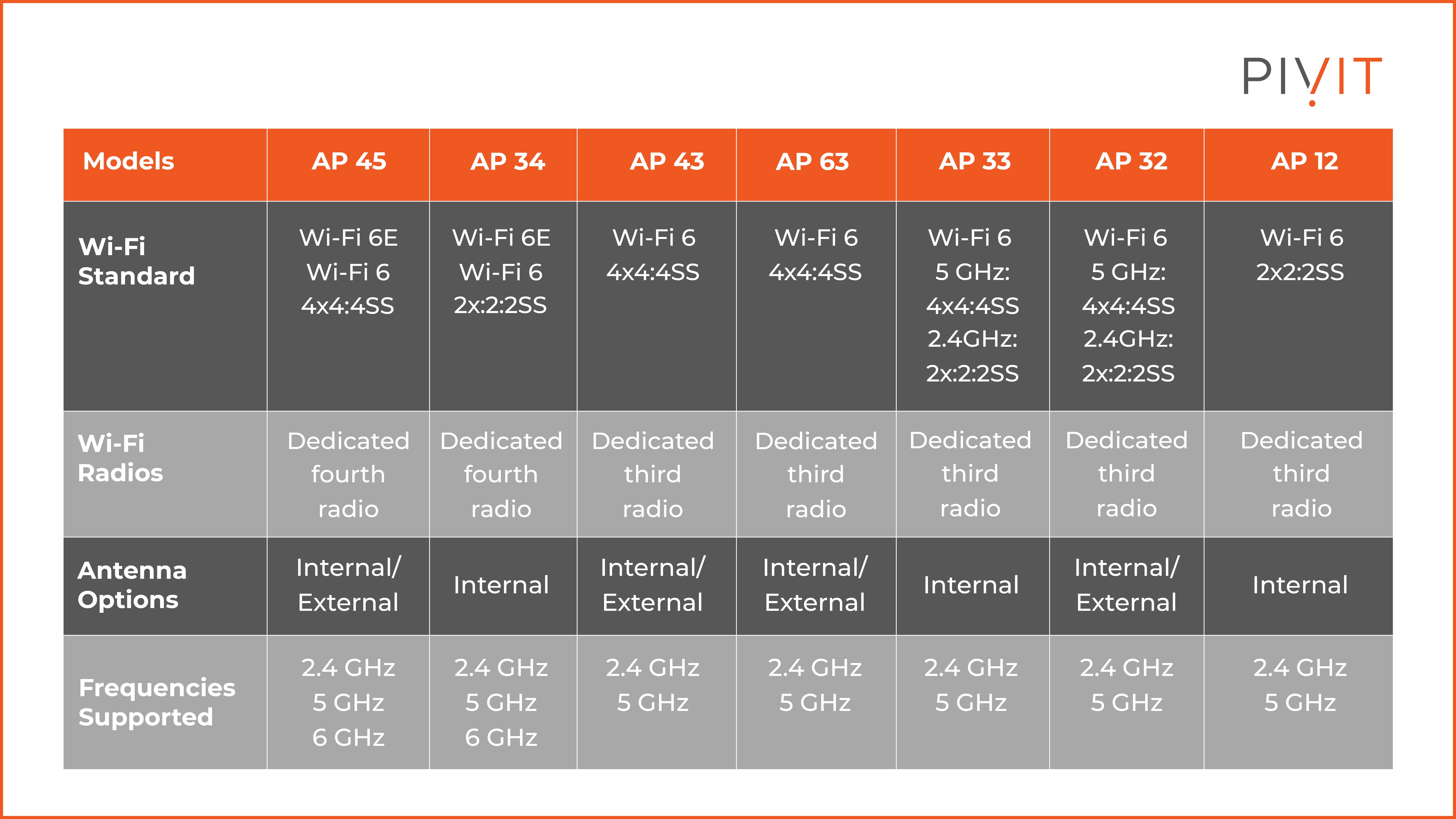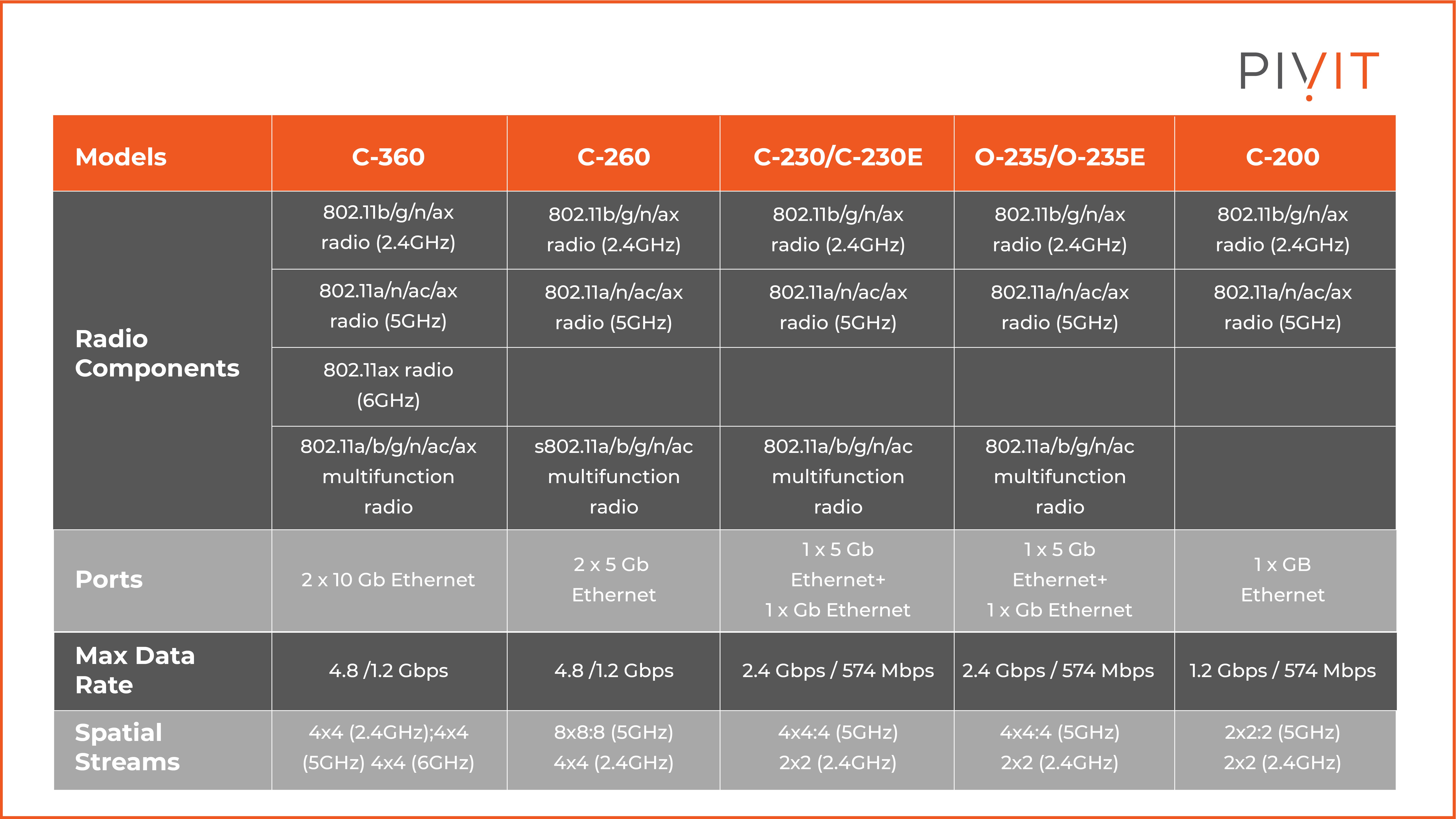Head-to-Head Wi-Fi 6E Tech: Juniper AP45 and AP34 vs. Arista C-360
.png)
According to the State of IoT - Spring 2022 report, the number of Wi-Fi-enabled devices is expected to reach 14.4 billion by the end of 2022. If you think that number is a lot, they expect it to grow to 27 billion by 2025! Wi-Fi network technology needs to keep up to support this trend.
Wi-Fi 6, also known as 802.11ax, is the latest generation of the Wi-Fi network protocol. The protocol is an upgrade from Wi-Fi 5 and offers enhanced wireless access capabilities.
Some benefits of Wi-Fi 6 that make it alluring include fast speeds, support for more access points (APs) per unit area, support for applications with diverse Quality of Service (QoS) needs, uplink resource allocation, and support for more concurrent clients per AP. Wi-Fi 6E, introduced by the Wi-Fi Alliance in 2020, is a Wi-Fi 6 extension that supports the operation of features in the 6 GHz, 5 GHz, and 2.4 GHz bands.
Juniper and Arista Networks have been at the forefront of enabling the adoption of Wi-Fi 6 and Wi-Fi 6E technologies. The two manufacturers have developed several devices to support the technologies, including switches and access points. Juniper AP45, Juniper AP34, and Arista C-360 are examples of Wi-Fi 6E APs.
In the rest of this article, we will explore the differences between Juniper AP45, Juniper AP34, and Arista C-360. Also, check out our other wireless product comparison articles:
- Juniper Mist AI and Cisco Battle for a Spot in Your Wireless Network
- Product Comparison: AIR-CT 2504 vs. AIR-CT 3504 Wireless Controllers
Juniper Networks Wi-Fi 6E Solution Overview
Juniper Networks has been a key contributor in the Wi-Fi 6 technology space. The company is also committed to providing innovative and high-performance network infrastructure to support enterprises in realizing the benefits of the new Wi-Fi 6E.
Since Wi-Fi 6E supports features in the 6 GHz band, it requires multigigabit ethernet (802.3bz) connectivity to the access layer switching devices. The Juniper EX Series of ethernet switches support 802.3bz connections. They can meet the high bandwidth capacity need created by the surge in access point uplink requirements.
Juniper APs, powered by Mist AI and Juniper Mist Cloud, offers high-end enhanced wireless access capabilities. Juniper Mist Edge supports new applications at the edge and extends microservices to the campus network for agility and scale.
Juniper Mist and PivIT share a core belief in software-defined networking, focusing on bringing AI to IT to simplify operations and improve customer experience. Learn more about PivIT's partnership with Juniper Mist and how you can access the benefits of the Mist AI Platform. Take a look at our wireless hardware options below:
The Automated High-Performance Juniper AP45 and Juniper AP34
.jpg?width=1920&name=1%20(9).jpg)
The Juniper AP45 is a tri-band Wi-Fi 6E device designed to meet large enterprises' increased channel widths and capacity needs. It consists of a 16-element virtual BLE antenna array and an automated fourth radio.
Juniper AP34 is also a tri-band Wi-Fi 6E device that offers a blend of Mist AI for AX™ and an omnidirectional Bluetooth antenna to support network automation and high performance in the 6 GHz band.
Both APs optimize operator and user experiences with secure, near-real-time client-to-cloud automation, insight, and actions.
Juniper AP45 and AP34 Key Features and Benefits
The section below outlines the key capabilities and benefits of the Juniper AP45 and AP34:
- High-Performance Wi-Fi Access: The AP45 is a four-spatial stream device with data rates of up to 4800 Mbps in the 6 GHz band, 2400 Mbps in the 5 GHz band, and 1148 Mbps in the 2.4 GHz band. AP34 is a two-spatial stream device with data rates of up to 2400 Mbps in the 6 GHz band, 1200 Mbps in the 5 GHz band, and 575 Mbps in the 2.4 GHz band.
- AI for AX™: This feature boosts efficiency by automatically assigning network clients to the best radio, optimizing basic service set (BSS) coloring, and automating AP-to-client data transmission scheduling.
- Automatic Radio Frequency (RF) Optimization: Radio Resource Management (RRM) leverages AP45 and AP34's dedicated sensor radios to assign channels and power automatically. The sensor radios can detect interferences from other sources on the channel.
- Prime Insights: A dedicated radio in each AP gathers data for the Proactive Analytics and Correlation Engine (PACE). Juniper AP45 and AP34 use machine learning techniques to analyze and gain insight from data on user experience, network issues, and the root cause of problems.
- Dynamic Packet Capture: The Juniper Mist platform can dynamically capture data packets and stream them to the cloud when it detects major network issues.
- Simple Cloud-Based Setup and Updates: AP45 and AP34 are easy to configure and update. They automatically connect to the cloud, download their configuration, and join an appropriate network. The two devices can also access firmware updates on the cloud and upgrade automatically.
- Excellent Analytics: Juniper Mist Wi-Fi Assurance, User Engagement, and Asset Visibility are available with the AP45 and AP34 that can analyze a vast collection of data (up to 30 days' worth). With these services, you can quickly gather insights from data and analytics across the enterprise network and use them to improve user and operator experience.
Juniper Wi-Fi 6 and 6E Access Points Specifications
Juniper's Wi-Fi 6 and 6E AP family includes AP34, 45, 43, 33, 12, 63, and 32. The table below provides a comparison of the AP specifications.

Arista Wi-Fi 6 and 6E Solution Overview
Arista Networks defines Wi-Fi 6 as a transformational Wi-Fi technology with a myriad of capabilities designed to increase Wi-Fi network capacity, efficiency, coverage, and end-user Quality of Experience.
Arista Networks is dedicated to providing high-performance and high-quality APs that support all the Wi-Fi 6 features. Some critical Wi-Fi 6 features include orthogonal frequency-division multiple access (OFDMA), downlink/uplink multi-user, multiple inputs, multiple outputs (DL/UL MU-MIMO), and Dual Carrier Modulation (DCM). Arista Wi-Fi 6E solutions bring all these features to 6 GHz clients.
The High-Capacity, High-Performance Arista C-360 AP
.jpg?width=1920&name=2%20(8).jpg)
Arista C-360 is a tri-band Wi-Fi 6E AP designed to meet the security and increased Wi-Fi capacity required by enterprises. Using this AP, enterprises can securely extend their networks to support new users and IoT devices.
The AP is supported by Arista's CloudVision Wi-Fi and delivers investment protection, fault tolerance for critical operations, gigabit speeds, and low latency.
Arista C-360 extends Arista's mature big data AI/ML-driven Cognitive Unified Edge (CUE) solution. CUE enables an automated cognitive campus and offers high availability for operators, users, and IoT devices across wired and wireless networks.
Moreover, it provides configuration and monitoring, application visibility and control, mature machine learning-based troubleshooting with advanced root cause analysis, a wireless intrusion prevention system (WIPS), and a unified database.
____________
Before we get into the features and benefits of the Arista C-360 AP, it is important to determine whether you have the resources to install and configure these APs. Ask yourself the following questions:
- Do I have the knowledge to configure my devices?
- Do I have the bandwidth to configure my devices?
If you answered "No" to either of these questions, consider PivIT's SmartHands through EXTEND. Hire an expert routing engineer to take on these configurations and more. Click below to learn more about SmartHands.
____________
Arista C-360 AP Key Features and Benefits
This high-end enterprise-grade AP delivers the following features and benefits:
- High Capacity: The AP offers three access radios. The 2.4 GHz radio supports legacy clients, while the dual 5 GHz radios support the 5 GHz clients. One of the 5 GHz radios can be converted and used to support 6 GHz clients if more of them become available.
- Analytics: One of the most significant features of the C-360 is real-time telemetry. C-360 supports various types of network analytics, including compliance and risk analysis and correlation and trend analysis.
- Security: Arista C-360 adds a triple band radio to its predecessors. It is used for the wireless intrusion prevention system (WIPS) to provide security for Wi-Fi clients. It also provides complete network visibility and control that enhances network protection. Furthermore, Arista's Marker Packets service continuously monitors wired and wireless VLANs to detect rogue APs on the network.
- Simple Cloud-Based Setups: C-360 has plug-and-play provisioning on-premises and in the cloud. AP activation and configuration on the cloud take a maximum of two minutes.
- Smart Load Balancing: This capability manages network traffic distribution across neighboring APs to ensure optimum use of network resources.
- Fault Tolerance: Arista C-360 contains dual 10 GB Ethernet ports that provide an automatic 60W failover. This feature is essential for critical operations.
- Multipurpose Radio: C-360 consists of a versatile tri-band radio that ensures consistent network availability.
Arista Wi-Fi 6 and 6E AP Family Specifications
The Arista Wi-Fi 6 and 6E AP family consists of Arista AP C-360, C-260, C-230/C-230E, O-235/O-235E, and C-200. The table below outlines the main differences between these APs.

Juniper AP45 and AP34 vs. Arista C-360 Comparison Summary
In summary, Juniper AP45, AP34, and Arista C-360 are high-performance access points. They can all be activated and configured easily on the cloud and on-premises. They also offer exceptional analytics that can provide you with insights and help you enhance the user experience.
Juniper's solutions have dedicated radios to gather data for PACE. They can support analytics on up to 30 days' worth of data. Juniper AP45 and AP34 also automate numerous network operations such as troubleshooting, packet capture, RF optimization, and AP-to-client data transmission scheduling.
On the other hand, Arista's C-360 offers excellent network security with enhanced network visibility, the Wireless Intrusion Prevention System (WIPS), and rogue AP detection. Arista's solution also ensures high network availability and performance assurance.
If you are still unsure which AP would best suit your network, send PivIT a request or connect with our Team in real-time using our chat feature.

